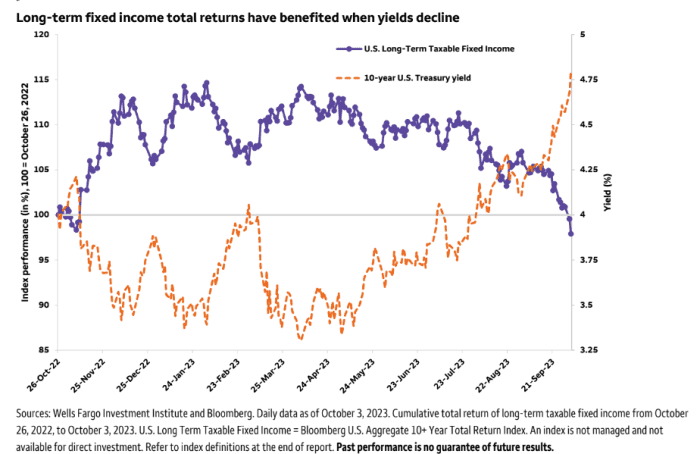Long-term bonds look appealing to Wells Fargo Investment Institute after they were hurt by a surge in yields.
Losses on long-term bonds recently deepened as rising yields sent their prices lower, with the rate on the 10-year Treasury note jumping to a 16-year higher earlier this month.
“Despite rising yields, we remain favorable on duration and buyers of long-term fixed income,” said Luis Alvarado, global fixed income strategist at Wells Fargo Investment institute, in a note dated Oct. 9. “Yields at these levels are potentially good entry points to consider for dollar-cost averaging.”
The substantial rise in U.S. Treasury yields over the past three weeks largely was influenced by the Federal Reserve vowing to keep interest rates higher for longer, with the hurdle to cut rates appearing “quite high,” according to the note.
Yet fixed-income portfolios stand to benefit as some investors anticipate a potential economic recession that may lead to rate cuts by the Fed in 2024. A drop in yields would be good for performance as that would drive up prices on long-term bonds, the chart below shows.

WELLS FARGO INVESTMENT INSTITUTE NOTE DATED OCT. 9, 2023
“In the past five Fed hiking cycles, we have observed that long-term yields tended to peak before the end of the tightening cycle,” said Alvarado.
The yield on the 10-year Treasury note
BX:TMUBMUSD10Y
was tumbling about 16 basis points on Tuesday to around 4.65%, according to FactSet data, at last check. Two-year yields
BX:TMUBMUSD02Y
were meanwhile down 11 basis points at around 4.97%.
While the yield curve has been inverted, with shorter-term rates above long-term ones, yields on Treasurys with longer durations recently have risen in a so-called bear steepening.
“So far, we have experienced what we call in bond jargon a ‘bear steepening’ of the yield curve,” said Alvarado. That means “yields on the long end of the curve have been moving higher (driving prices lower),” he wrote “while yields on the short end have remained flat, effectively causing a steepening of the curve.”
Read: ‘It’s been a bloodbath’: Long-term bond ETFs deepen losses after hotter-than-expected jobs report
Wells Fargo doesn’t see much keeping long-term yields from continuing their push higher because of several factors including expectations for increased Treasury issuance, rising debt levels, higher debt costs, “some dysfunction in Washington” and consumers that are so far resilient, according to Alvarado.
Rising yields have pummeled exchange-traded funds that invest in long-term bonds, but as yields retreated on Tuesday, shares of the iShares 20+ Year Treasury Bond ETF
TLT
and iShares 10-20 Year Treasury Bond ETF
TLH
were down slightly in afternoon trading after rising sharply on Monday when the bond market was closed because of Columbus Day.
Read: How 10-year Treasurys could produce 20% returns, according to UBS
